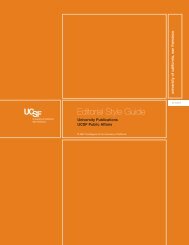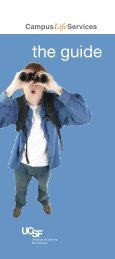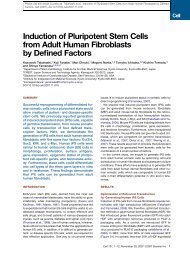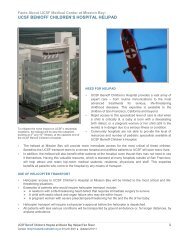2009 Progress Report (PDF)
2009 Progress Report (PDF)
2009 Progress Report (PDF)
Create successful ePaper yourself
Turn your PDF publications into a flip-book with our unique Google optimized e-Paper software.
Campus Two-Year Goals: <strong>Progress</strong> <strong>Report</strong><br />
A <strong>Report</strong> to UC President Mark Yudof<br />
October <strong>2009</strong>
SF is a<br />
leading<br />
u<br />
Near Term (two-year) Priorities and <strong>Progress</strong><br />
OVERVIEW<br />
UCSF developed a Campus Two-Year Goals Statement in December 2008. The six principal long-range goals articulated<br />
in this statement are:<br />
• Develop the world’s future leaders in health care delivery, research and education.<br />
• Be a world leader in scientific discovery and its translation into exemplary health.<br />
• Provide high-quality, patient-centered care leading to optimal outcomes and patient satisfaction.<br />
• Educate, train and employ a diverse faculty, staff and student body.<br />
• Provide a supportive and effective work environment to attract and retain the best people and position UCSF<br />
for the future.<br />
• Serve our local, regional and global communities and eliminate health disparities.<br />
These goals stem from a highly inclusive two-year strategic planning process which resulted UCSF’s first-ever campuswide<br />
strategic plan, which charts the University’s course as a global leader in health sciences over the next two decades.<br />
“Advancing Health Worldwide: A Strategic Plan for UCSF was published June 2007 and can be viewed at<br />
www.strategy.ucsf.edu.<br />
In developing the goals statement, the Chancellor’s Executive Committee identified the following five near-term (two-year)<br />
priorities for the campus:<br />
• Maintain competitiveness in recruiting the best students by fostering inter-disciplinary educational programs,<br />
enhancing student life, increasing student financial support, and improving educational facilities and infrastructure.<br />
• Recruit, develop and retain the highest-caliber faculty and staff by addressing climate issues.<br />
• Optimize the quality of clinical services with a patient-centered focus and expand clinical capacity to address<br />
immediate and long-term capacity needs.<br />
• Create a more diverse community, and ensure that UCSF continues to attract the best and most diverse candidates<br />
for faculty, staff, and students-trainees in all educational programs.<br />
• Enhance resource management practices, and provide facilities and infrastructure (administrative and technological)<br />
necessary to accommodate academic strategic priorities.<br />
For each priority, a set of indicators was established to measure annual progress. This report summarizes the progress<br />
made achieving these priorities during the academic year 2008-<strong>2009</strong>.<br />
1
PRIORITY: Maintain competitiveness in recruiting the best students by fostering interdisciplinary<br />
educational programs, enhancing student life, increasing student<br />
financial support, and improving educational facilities and infrastructure.<br />
SIGNIFICANCE<br />
Near Term (two year) Priorities and <strong>Progress</strong><br />
UCSF’s continued academic excellence is linked to our success in recruiting and adequately supporting the best students<br />
from throughout the country and world. Implementation of this priority will contribute to the campus’ achievement of three<br />
long-range goals: (1) Develop the world’s future leaders in health care delivery, research and education and (2) Educate,<br />
train and employ a diverse faculty, staff and student body and (3) Be a world leader in scientific discovery and its<br />
translation into improved health.<br />
INDICATORS AND PROGRESS IN ACADEMIC YEAR 2008-<strong>2009</strong><br />
Continued success in recruiting and retaining talented and diverse students<br />
• Increased the proportion of underrepresented students enrolled at UCSF from 19% in Fall 2007 to 22% in Fall 2008.<br />
• Maintained the retention rate of UCSF students of over 96% in 2008.<br />
• Maintained the ratings for professional and graduate programs. Ratings according to U.S. News and World <strong>Report</strong><br />
(USNWR) are: Medicine (5 th ); Nursing (2 nd ); Pharmacy (1 st ). Many graduate programs are ranked in the top 10<br />
nationally. Dentistry programs are not ranked by USNWR.<br />
Development and enhancement of educational facilities and infrastructure<br />
• Upgraded technology and furniture in 40 classrooms at Parnassus and Mission Bay; installed new robust wireless<br />
system at Parnassus, Mission Bay, and Laurel Heights.<br />
• Established first-ever endowment to sustain classroom improvements.<br />
• Approved and funded new Center for Teaching and Learning at Parnassus (scheduled to open in 2011).<br />
• Opened new classrooms at Mission Bay and Laurel Heights.<br />
• Implemented new on-line learning platform.<br />
Growth in graduate and professional student enrollment (pending additional resources)<br />
• Enrollment growth has been delayed due to the state’s budget crisis.<br />
Increased student financial support (and decrease in loan debt)<br />
• Increased student financial support from $96 million in 2007-08 to $115 million (20%) in 2008-09. Grant/fellowship<br />
funds increased from $46 million to $53 million (16%). The average loan debt for students in the School of Dentistry<br />
decreased between 2007-08 and 2008-09 (from $139,000 to $138,000). However, the average loan debt increased<br />
for other students – medicine (from $99,000 to $108,000), nursing ($27,000 to $30,000), pharmacy ($87,000 to<br />
$97,000) and Graduate Division ($19,000 to $20,000) during this period.<br />
• Established student aid as a priority for the campus’ next development campaign.<br />
2
PRIORITY: Maintain competitiveness in recruiting the best students by fostering interdisciplinary<br />
educational programs, enhancing student life, increasing student<br />
financial support, and improving educational facilities and infrastructure.<br />
INDICATORS AND PROGRESS IN ACADEMIC YEAR 2008-<strong>2009</strong> - continued<br />
Continued access to quality student wellness and mental health services<br />
• Enhanced student wellness and mental health services and maintained wait period for mental health counseling<br />
services at one week or less.<br />
Near Term (two year) Priorities and <strong>Progress</strong><br />
Reaffirmation of Western Association of Schools and Colleges (WASC) accreditation in 2010<br />
• Completed successfully the Capacity and Preparatory Review and advanced to Educational Effectiveness Review in<br />
June <strong>2009</strong>. Educational Effectiveness Review report due in Summer 2010 and site visit scheduled for October 2010.<br />
3
PRIORITY: Recruit, develop, and retain the highest caliber faculty and staff by addressing<br />
climate issues.<br />
SIGNIFICANCE<br />
Near Term (two year) Priorities and <strong>Progress</strong><br />
Faculty are the core of the University because they are responsible for teaching, generating and disseminating new<br />
knowledge, and clinical care. In recognition of the current budget situation, our emphasis will be on improving the climate<br />
for faculty rather than increasing compensation. We believe faculty are willing to accept somewhat lower compensation for<br />
the opportunity to work with senior investigators who are leaders in their field and are committed to helping junior<br />
colleagues succeed. Needs identified in the 2001 climate survey included: increased welcoming activities, increased<br />
mentoring, increased leadership opportunities and training, increased faculty development activities and improvements in<br />
the work-life balance. Without the highest caliber faculty, UCSF will not attract and educate the best students and<br />
graduates, maintain our research profile, and provide innovative clinical care. Improving the climate for staff also is<br />
essential to supporting the academic community.<br />
INDICATORS AND PROGRESS IN ACADEMIC YEAR 2008-<strong>2009</strong><br />
Delineate reasons for leaving UCSF by implementing a faculty exit survey and collecting staff data<br />
• Completed survey and plans to submit an RFP for its conduct. However, the faculty exit survey has been delayed in<br />
order to capture data required. The survey will be conducted by an outside company to maximize faculty<br />
participation.<br />
• Collected data over the last 18 months from 842 staff respondents (34.5% of those who have voluntarily left UCSF<br />
during that period) cite five key reasons why individuals leave UCSF. Details have been shared with the Executive<br />
Committee and Staff Worklife Committee to address as appropriate.<br />
Attendance at and evaluations of programs designed to improve faculty or staff life<br />
Chancellor’s Council on Faculty Life programs are so designed in response to faculty climate survey.<br />
• Faculty Information and Welcoming Week <strong>2009</strong><br />
Attendance: Plenary session: 80; workshop average 74; luncheon programs: VAMC: 35; LHTS: 120; SFGH: 40<br />
Evaluations under analysis<br />
• Faculty Mentoring Program 2008-09: 748 pairs of 853 eligible mentees<br />
Lifetime Achievement in Mentoring Award given for 3 rd time; 21 nominations; keynote speaker Eric Liu, author of<br />
Guiding Lights: How to Mentor - and Find Life's Purpose, the Official Book of National Mentoring Month; Attendance: 150-200<br />
• UCSF-Coro Faculty Leadership Collaborative. This program is offered at no cost to departments or participants<br />
and serves twin goals of faculty recruitment/retention and development of faculty leaders.<br />
16 participants in Fall 2008, total of 94 program graduates, Spring 2010 program for up to 16 faculty in application<br />
phase. Evaluations of 2008 program: 100% of participants rated the program as highly or somewhat effective for<br />
all 3 outcomes; 73% of participants rated the program has highly effective for enhancing their leadership abilities<br />
4
PRIORITY: Recruit, develop, and retain the highest caliber faculty and staff by addressing<br />
climate issues.<br />
INDICATORS AND PROGRESS IN ACADEMIC YEAR 2008-<strong>2009</strong> – continued<br />
Near Term (two year) Priorities and <strong>Progress</strong><br />
• Faculty Development Program. Two workshops were held during 2008-09:<br />
An Insider’s Guide to Advancement and Promotion at UCSF - VPAA and Vice/Associate Deans for Academic<br />
Affairs (attendance 85 at Parnassus, 15 at Fresno) – Evaluation: 84% rated the overall value of the session as a<br />
6 or 7 on a scale of 1 to 7.<br />
“That’s Not What I Meant” Managing Conflict Effectively - Edward O’Neil, Professor, UCSF; Ellen Beilock, UCSF<br />
Campus Mediation Officer (attendance ~55)<br />
• Wellness Grand Rounds - quarterly series on work-life balance/wellness issues. Five lectures were held, two of which<br />
introduced a related course for faculty. All lectures were videotaped & were or are being posted on the Academic Affairs<br />
web.<br />
Why Zebras Don’t Get Ulcers and Faculty Do: Stress and Health - Robert M. Sapolsky, John A. and Cynthia Fry<br />
Gunn Professor, Dept. of Biological Sciences, Stanford University Depts. of Neurology & Neurological Sciences &<br />
of Neurosurgery<br />
Attendance: 236 including Mission Bay and Fresno via simulcast<br />
Evaluations: 72% of responders rated the lecture as valuable or somewhat valuable<br />
Retraining the Brain for Resiliency and Joy - Laurel Mellin<br />
Attendance: ~120, plus related course of 6 sessions (attendance 8)<br />
Evaluations: 68% of responders rated the lecture as valuable or somewhat valuable<br />
Mindfulness and Well-Being - Kevin Barrows, HS Asst. Clin. Prof of Family & Community Medicine & Director of<br />
Mindfulness Programs for the Osher Center for Integrative Medicine<br />
Attendance: ~ 50, plus related course of 9 sessions (19 participants)<br />
Evaluations: 100% of responders rated the lecture as valuable or somewhat valuable - Course Evaluations:<br />
100% of responders rated the course between 8 and 10 on a 10 point scale (10 being most valuable); 64% rated the<br />
course as a 10.<br />
Healthy Aging for the Health Professional - Donald Abrams, Professor of Clinical Medicine and Osher Foundation<br />
Endowed Chair in Clinical Programs in Integrative Medicine<br />
Attendance: ~50 - Evaluations: 92.3% of responders rated the lecture as valuable<br />
Positive Emotion in the Midst of Stress - Judith Moskowitz, Associate Adjunct Professor, Osher Center for<br />
Integrative Medicine<br />
Attendance: ~50 Evaluations: 100% of responders rated the lecture as valuable.<br />
• New Faculty Biography Program – biographies of new faculty posted on UCSF Today website.<br />
2008-09: 41 new faculty our of 98 (42%) posted their biographies<br />
5
PRIORITY: Recruit, develop, and retain the highest caliber faculty and staff by addressing<br />
climate issues.<br />
INDICATORS AND PROGRESS IN ACADEMIC YEAR 2008-<strong>2009</strong> – continued<br />
Near Term (two year) Priorities and <strong>Progress</strong><br />
• The Chancellor’s Council on Staff Worklife continues to meet monthly to lead efforts to address feedback from staff<br />
opinion survey and to advice leadership on other staff programs (e.g., Voluntary Separation Program, Everyday<br />
Errands – employee concierge service, etc.)<br />
• There are at least 12 Chancellor’s Committees that continue to meet regularly to address and advise on programs to<br />
improve faculty and staff life.<br />
Faculty satisfaction as indicated in the <strong>2009</strong> UCSF Faculty Climate survey<br />
• Survey has been postponed. Given the current UC budget issues, we are concerned that conducting a survey now<br />
would result in comments primarily about the budget rather than about other faculty climate issues. This would<br />
preclude us from obtaining data that accurately reflects changes to faculty climate since the original survey was<br />
conducted. The survey instrument has been updated and is ready; we intend to conduct the survey in Spring 2011.<br />
Staff satisfaction as indicated in on-going staff climate surveys<br />
• In Spring 2008 UCSF conducted its fourth biennial staff opinion survey, key findings from the survey are available.<br />
Implementation of projects that improve the daily life of faculty and staff at UCSF (e.g. child care expansion,<br />
improved support to research and teaching activities through automation and process improvement)<br />
• UCSF is opening its fourth child care center in November <strong>2009</strong>, which will serve about 72 children at the Parnassus<br />
campus.<br />
• New Leadership Development Program created for staff to improve our leaders’ skills and competencies in order to<br />
respond to advancement opportunities and growth.<br />
• For several years the UCSF Medical Center has provided employee concierge services. Beginning in September<br />
<strong>2009</strong> the program “Everyday Errands” was expanded to the campus as well as patients and families.<br />
• The campus is implementing a time and attendance program beginning in November <strong>2009</strong> (the UCSF Medical<br />
Center implemented the same program several years ago) to streamline and automate the process of approving<br />
employee time off, to document leave accruals and to position the campus to implement vacation leave accrual in<br />
November 2010.<br />
• Online human subjects approval process will be rolled out later this calendar year.<br />
• New Workforce Planning program developed: a systematic program to gather data on our current workforce and to<br />
help us understand future staffing needs within an organization. The faculty exit survey has been delayed in order to<br />
capture data required by UCOP which will reflect the impact of the furlough program.<br />
6
PRIORITY: Optimize the quality of clinical services with a patient-centered focus and expand<br />
clinical capacity to address immediate and long-term capacity needs.<br />
SIGNIFICANCE<br />
UCSF’s continued clinical excellence is linked to continuous improvement in the quality, safety, and effectiveness of our<br />
care and of our patients’ rating of access, service, and amenities. In addition it is important we develop the capacity to<br />
provide service to all who can benefit from medical, dental, pharmacy, and nursing care at UCSF.<br />
Near Term (two year) Priorities and <strong>Progress</strong><br />
INDICATORS AND PROGRESS IN ACADEMIC YEAR 2008-<strong>2009</strong><br />
Quality, patient safety and patient satisfaction metrics<br />
• Central Line Infection Rates: Central Line-related bloodstream infections (CRBSI) were reduced from 4.88 to 2.3 (50%)<br />
during FY09, and to 1.9 in the first 2 months of FY10. Efforts to continue reducing CRBSI include physician and nurse<br />
training, including 1:1 clinician observation and feedback, and dressing material and IV line product conversions.<br />
• Medication Reconciliation: One national priority for improving medication safety is the institution of accurate medication<br />
reconciliation when a patient moves from one care setting to another. In short, this entails a detailed review of a<br />
patient’s past, present, and new proposed medications to be sure all information is accurate and that the combination of<br />
medications is appropriate and safe. During FY08-09, UCSF medical center developed, piloted, and fully implemented<br />
a reliable electronic tool to assist physicians in completing medication reconciliation when a patient transfers units within<br />
the hospital. For FY09-10, we will pilot similar systems to assure accurate medication reconciliation on admission to and<br />
discharge from the hospital.<br />
• Patient Portal: In March <strong>2009</strong>, UCSF Medical Center launched its patient portal, UCSF MyHealth. The portal offers<br />
patients services in: secure messaging with their physician; appointment requests; lab results review; e-Visits;<br />
electronic pharmacy refills; and creation of a personal health record. Currently 56 physicians and 26,000 patients can<br />
access the system. The plan is to rollout MyHealth to another 60 physicians by Spring 2010. MyHealth can be found at:<br />
http://www.ucsfhealth.org/adult/contact/myhealth/index.html<br />
• Staff Training/Patient Communication: UCSF’s Everyday PRIDE for Everyone Series addresses staff training in the<br />
fundamentals of patient communication. Courses provide employees with tools and appropriate techniques. During<br />
December 2008 through September <strong>2009</strong>, 28 classes were offered with 272 attendees.<br />
7
PRIORITY: Optimize the quality of clinical services with a patient-centered focus and expand<br />
clinical capacity to address immediate and long-term capacity needs.<br />
INDICATORS AND PROGRESS IN ACADEMIC YEAR 2008-<strong>2009</strong> – continued<br />
Near Term (two year) Priorities and <strong>Progress</strong><br />
• School of Dentistry: The conversion to digital radiography began in 2008. The conversion in the predoctoral clinics<br />
was completed prior to the end of the 2008-09 academic year. Digital radiography results in approximately 70% less<br />
radiation per exposure, making it far safer for our patients. Patient care is more efficient since digital images are<br />
instantly available. Additionally, digital radiography is better for the environment since it eliminates the use of harmful<br />
chemicals and materials. Images are automatically labeled and archived in the electronic patient record so there is<br />
no problem with loose x-rays, containing protected patient information, falling out of patient charts. Another<br />
advantage of digital images is that you can alter the contrast to help discern hard and soft tissue structures.<br />
<br />
There has been an emphasis on customer service and patient communication. Patient Satisfaction Surveys are<br />
distributed throughout the year. During the period December 2008 through September of <strong>2009</strong>, the Patient<br />
Satisfaction Surveys indicated greater than 90% satisfaction in the following categories.<br />
Positive Overall Impression of the School of Dentistry<br />
Will Tell Friends They Had Positive Experience at School<br />
Oral Health Has Improved After Treatment in School<br />
Satisfaction With Dental School Experience<br />
Dental Procedures Were Performed to Patient’s Satisfaction<br />
Overall Satisfaction With Clinicians<br />
Deployment of an inpatient electronic medical record system (“UCare”)<br />
• In August <strong>2009</strong>, UCSF Medical Center management terminated the UCare Project development partnership with GE<br />
Healthcare due to longstanding product development delays and increasing financial expenditures. The Project<br />
terminated for an indefinite period of time into the future. Notwithstanding this setback, we remain committed to the<br />
development of an integrated (inpatient and outpatient), comprehensive EMR. We have initiated the process to<br />
secure a reliable and comprehensive system with all deliberate speed. In the meantime, the portions of UCare that<br />
are currently being operated will remain in service while the new system is procured and implemented.<br />
8
PRIORITY: Optimize the quality of clinical services with a patient-centered focus and expand<br />
clinical capacity to address immediate and long-term capacity needs.<br />
INDICATORS AND PROGRESS IN ACADEMIC YEAR 2008-<strong>2009</strong> - continued<br />
Near Term (two year) Priorities and <strong>Progress</strong><br />
Increase our capacity<br />
• In October 2008, Moffitt-Long Hospital opened the 13ICU with 16 beds.<br />
• The Orthopaedic Institute at Mission Bay opens on October 1, <strong>2009</strong>. Through the Orthopaedic Institute, the<br />
Department of Orthopaedic Surgery will bring the first patient-care and research combined facility to Mission Bay.<br />
The newly constructed building will house many of our state-of-the-art programs and advanced patient services in<br />
conjunction with ancillary services to simplify and accentuate our patients' visits.<br />
• Opening of one new OR on October 5, <strong>2009</strong>. We anticipate opening the second new OR in March 2010.<br />
• To date (Sept <strong>2009</strong>), funds raised equal $225M and we are on track for $470M by November 2010.<br />
• In July 2008, the School of Dentistry increased the clinical hours of operation by one hour each day, without any<br />
change in the operational hours (8am-5pm). This was accompanied by a marketing campaign and an overhaul of the<br />
following systems.<br />
Appointment system (and scheduling guidelines)<br />
Accounts receivables management and revision of financial policies<br />
Phone systems<br />
Re-design of School’s web site<br />
• The net result was an increase in capacity and patient care. For the period December 2008 through September of<br />
<strong>2009</strong>, a year-to-date comparison with the prior year shows the following increases.<br />
47% Increase in Number of Dental Procedures<br />
19% Increase in number of Patients Seen<br />
17% Increase in Patient Visits<br />
20% Increase in Production<br />
23% Increase in Patient Revenue<br />
9
PRIORITY: Create a more diverse community, and ensure that UCSF continues to attract the<br />
best and most diverse candidates for faculty, staff, students and trainees in all<br />
educational programs.<br />
SIGNIFICANCE<br />
Near Term (two year) Priorities and <strong>Progress</strong><br />
If UCSF is to attract and retain the best faculty, students, and staff, we must build upon our commitment to diversity and<br />
establish a climate and culture that welcomes, celebrates and promotes respect for the contributions of all faculty, staff,<br />
students and trainees. Diversity is a defining feature of California’s past, present and future and refers to the variety of<br />
personal experiences, values and worldviews that arise from differences in culture and circumstance. Such differences<br />
include race, ethnicity, gender, age, religion, language, abilities/disabilities, sexual orientation, socioeconomic status and<br />
geographic region, among others.<br />
INDICATORS AND PROGRESS IN ACADEMIC YEAR 2008-<strong>2009</strong><br />
Participation in outreach programs tailored for potential students/trainees*<br />
• “Inside UCSF” Program: 135 participants in two programs in 2008-09, including many from outside the Bay Area.<br />
The majority of participants were African American/Black and Hispanic, over 50% were female and many were first<br />
generation college students. Another event is planned for Spring 2010.<br />
• Traveling Ambassador Program: Ambassadors traveled to six professional meetings across the country to make<br />
contact with potential candidates committed to diversity. Information on these contacts will be entered in a database<br />
to be matched to faculty vacancies. The program has expanded to include student outreach at historically minorityserving<br />
colleges, and to supplement advertisement costs of certain positions.<br />
• Outreach Taskforce Recommendations: Continue to implement recommendations by the Outreach Taskforce:<br />
Provide sustainable funding for programs that enhance recruitment/retention of diverse populations. Since the<br />
last report, financial support for maintaining and improving the Academic Demographic System was provided,<br />
and campus-wide personnel were trained to use the system.<br />
Foster a supportive campus climate that values, recognizes, and rewards individuals who promote recruitment<br />
and retention of diverse populations. All program activities support this recommendation.<br />
Enhance the academic success and increase the retention of diverse students by providing new support services<br />
for study and learning skills. A support group for first-generation college students was initiated. The Office of<br />
Student life hired a full-time learning specialist to enhance study and learning skills.<br />
* House staff, postdoctoral scholars, and clinical fellows.<br />
10
PRIORITY: Create a more diverse community, and ensure that UCSF continues to attract the<br />
best and most diverse candidates for faculty, staff, students and trainees in all<br />
educational programs.<br />
INDICATORS AND PROGRESS IN ACADEMIC YEAR 2008-<strong>2009</strong> - continued<br />
Near Term (two year) Priorities and <strong>Progress</strong><br />
Percentage of low and middle-income students admitted and offered scholarships to our professional schools<br />
and graduate programs<br />
• Grant/fellowship funds to students increased 16%.<br />
Diversity of senior leaders (defined as Chancellor, Executive Vice Chancellor and Provost, Vice Provosts, Vice<br />
Chancellors, Associate Vice Chancellors, Deans) and applicants for such positions<br />
• The current senior leader population of 21 at UCSF includes 10 males, 8 females; 2 Hispanics, 2 Asians and 1<br />
African-American. There are 3 vacancies.<br />
• Over the past year the representation of women has increased by 2 with the hiring of a Chancellor and Vice<br />
Chancellor-Development. The ethnic diversity has remained unchanged.<br />
• Over the past year several senior leader recruitments took place and each included conducting good faith efforts to<br />
seek a diverse pool of candidates.<br />
Diversity of applicants for faculty positions as shown in responses to demographic survey in Academic<br />
Demographic System matching available pool data<br />
• Response rate to applicant demographic survey increased from 2% to 70%. Increase attributed to replacing paper<br />
response system with electronic system.<br />
• There are 155 vacancies in the system and 30 have been closed with hires. Monitoring of applicant pool<br />
demographics prior to search closing will continue. To date, most of the applicant pools have been diverse<br />
compared with the availability pool. The Director plans to continuing meeting with departments that have open<br />
searches, focusing on those with no underrepresented minority faculty and other appropriate groups.<br />
Reasons for leaving UCSF in exit surveys<br />
• See Recruit, develop, and retain the highest-caliber faculty and staff by addressing climate issues section of progress<br />
report<br />
11
PRIORITY: Create a more diverse community, and ensure that UCSF continues to attract the<br />
best and most diverse candidates for faculty, staff, students and trainees in all<br />
educational programs.<br />
INDICATORS AND PROGRESS IN ACADEMIC YEAR 2008-<strong>2009</strong> - continued<br />
Near Term (two year) Priorities and <strong>Progress</strong><br />
Underutilization goals for staff positions from Equal Opportunity Affirmative Action (EOAA) and UCSF Affirmative<br />
Action Plan (AAP)<br />
• UCSF continues to conduct good faith efforts in our recruitments when an underutilization goal exists. In February<br />
<strong>2009</strong> Campus Human Resources launched an on-line Good Faith Efforts Affirmative Action Tool. For each new job<br />
that is posted, Campus Human Resources informs hiring managers if AAP goals exist and then provides resources to<br />
conduct, document and report “good faith efforts.”<br />
• Additional efforts to improve diversity include:<br />
Training program is in pilot stage that will provide training for supervisors and managers on diversity awareness<br />
best practices in diverse outreach, recruitment and retention.<br />
A proposal is being developed to create and budget financial and other incentives for departments engaging in<br />
good faith efforts to augment Chancellor’s best practices awards.<br />
The AAEOD unit will train and certify departmental human resources specialists in diversity values and<br />
expectations, including when to call for assistance.<br />
Campus Human Resources currently assists departments that continuously fail to meet affirmative action goals<br />
by advising them on how to strengthen recruitments and good faith efforts.<br />
12
PRIORITY: Enhance resource management practices, and provide facilities and infrastructure<br />
(administrative and technological) necessary to accommodate academic strategic<br />
priorities.<br />
SIGNIFICANCE<br />
Near Term (two year) Priorities and <strong>Progress</strong><br />
One of the major concerns identified in interviews of key stakeholders at UCSF was inadequate accountability and<br />
transparency, particularly financial. Insufficient accountability and transparency make it difficult for stewards of resources<br />
to fulfill their responsibilities, lead to concerns about fairness and openness, and result in a silo approach to deployment of<br />
resources. Performance-based resource allocation is a standard business practice that has successfully been established<br />
at other leading academic medical centers and is already in place at UCSF Medical Center. This approach would greatly<br />
benefit UCSF.<br />
INDICATORS AND PROGRESS IN ACADEMIC YEAR 2008-<strong>2009</strong><br />
Resources are allocated to facility and infrastructure priorities that are aligned with long-term strategic goals and<br />
near-term priorities identified in the UCSF Strategic Plan<br />
• Developed a new resource management model for UCSF and will begin testing it this fall with rollout scheduled for<br />
FY11. A suite of tools and analyses to support the new model was also developed.<br />
• Used principles consistent with the strategic plan in the FY09-10 resource allocation process. The few new<br />
allocations that were made were consistent with the plan's priorities. The UC general fund budget crisis severely<br />
hampered efforts to fund the plan's priorities.<br />
• Opened a new cancer research building and are constructing a new cardiovascular building and stem cell research<br />
building and are in the design stage of a new mission bay hospital.<br />
• Made available a secure Integrated Data Repository to provide secure, automated access to clinical information for<br />
research purposes.<br />
• Released the first phase of an automated system for managing faculty promotion and advancement and phase II is<br />
underway.<br />
• Opened a new, LEED-certified data center for UCSF on March <strong>2009</strong>.<br />
• Continued to expand a more capable and secure infrastructure for wireless access across campus sites.<br />
• Expanded and upgraded email and calendaring services to the campus.<br />
13



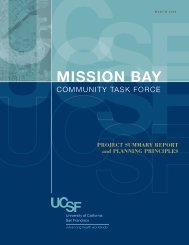
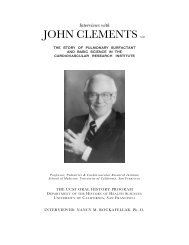
![UCSF Mt. Zion Parking Garage DEIR [PDF] - University of California ...](https://img.yumpu.com/27446936/1/190x245/ucsf-mt-zion-parking-garage-deir-pdf-university-of-california-.jpg?quality=85)

